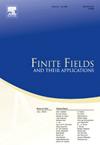On the study of semi-involutory and semi-orthogonal matrices
IF 1.2
3区 数学
Q1 MATHEMATICS
引用次数: 0
Abstract
This paper investigates semi-involutory and semi-orthogonal matrices, presenting two algorithms for verifying these properties for matrices over . The algorithms significantly reduce computational complexity by avoiding the need for non-singular diagonal matrices. The structure of circulant matrices with these properties is also explored, including the derivation of the exact form of their corresponding diagonal matrices. We further investigate MDS matrices with semi-involutory and semi-orthogonal properties. We prove that semi-involutory circulant matrices of order over , where , cannot be MDS matrices. Additionally, we show that semi-orthogonal circulant matrices of order over cannot be MDS. Finally, explicit formulas for counting semi-involutory and semi-orthogonal MDS matrices over are derived, and exact counts for semi-involutory and semi-orthogonal MDS matrices over for and 4 are provided.
半对合矩阵和半正交矩阵的研究
本文研究了半对合矩阵和半正交矩阵,给出了验证Fpm上n×n矩阵的这些性质的两种算法。该算法避免了对非奇异对角矩阵的需要,大大降低了计算复杂度。本文还探讨了具有这些性质的循环矩阵的结构,包括其对应对角矩阵的精确形式的推导。我们进一步研究了具有半对合和半正交性质的MDS矩阵。证明了n≥3阶/ F2m的半对合循环矩阵,其中gcd (n,2m−1)=1不能是MDS矩阵。此外,我们还证明了2n / F2m阶的半正交循环矩阵不可能是MDS。最后,导出了F2m上3×3半对合和半正交MDS矩阵的显式计数公式,并给出了m=3和4时F2m上4×4半对合和半正交MDS矩阵的精确计数。
本文章由计算机程序翻译,如有差异,请以英文原文为准。
求助全文
约1分钟内获得全文
求助全文
来源期刊
CiteScore
2.00
自引率
20.00%
发文量
133
审稿时长
6-12 weeks
期刊介绍:
Finite Fields and Their Applications is a peer-reviewed technical journal publishing papers in finite field theory as well as in applications of finite fields. As a result of applications in a wide variety of areas, finite fields are increasingly important in several areas of mathematics, including linear and abstract algebra, number theory and algebraic geometry, as well as in computer science, statistics, information theory, and engineering.
For cohesion, and because so many applications rely on various theoretical properties of finite fields, it is essential that there be a core of high-quality papers on theoretical aspects. In addition, since much of the vitality of the area comes from computational problems, the journal publishes papers on computational aspects of finite fields as well as on algorithms and complexity of finite field-related methods.
The journal also publishes papers in various applications including, but not limited to, algebraic coding theory, cryptology, combinatorial design theory, pseudorandom number generation, and linear recurring sequences. There are other areas of application to be included, but the important point is that finite fields play a nontrivial role in the theory, application, or algorithm.

 求助内容:
求助内容: 应助结果提醒方式:
应助结果提醒方式:


